Exploring Forms and Formalities in Land Conveyance - A Legal Essay
VerifiedAdded on 2023/05/30
|6
|1302
|394
Essay
AI Summary
This essay critically analyzes the prescribed formalities under the laws of the Land Property Act, short-term leases, and registration of deeds and wills of land and property. It highlights the requirements for formalities in the United Kingdom, emphasizing compliance with the LPA act 1925 section 53 (1) (b), which includes evidence of trust, signature, and declarations. The essay discusses scenarios such as simultaneous conveyance and the process of subdivision, electronic conveyance, and the two-phase process of land disposition: the contract of sale and the completion of land. It also covers the importance of registration, the differences between title and deed systems, and the role of property deeds and wills in confirming ownership and facilitating the transfer of property from one owner to another. The essay concludes that formalities of conveyance are essential for ensuring equal satisfaction to all parties involved in the sale and purchase of land, providing documented and electronically stored records of trust, interest, and agreements.
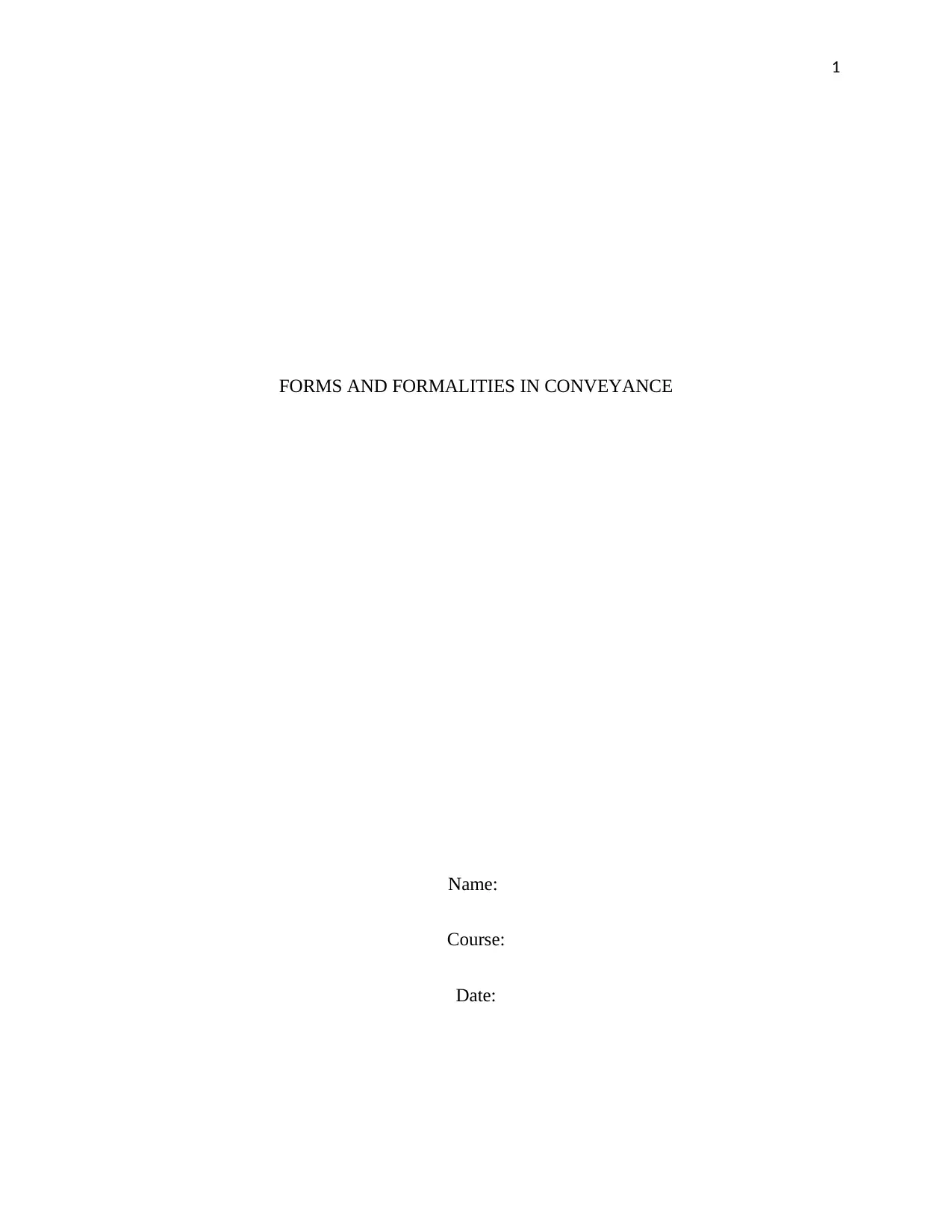
1
FORMS AND FORMALITIES IN CONVEYANCE
Name:
Course:
Date:
FORMS AND FORMALITIES IN CONVEYANCE
Name:
Course:
Date:
Paraphrase This Document
Need a fresh take? Get an instant paraphrase of this document with our AI Paraphraser
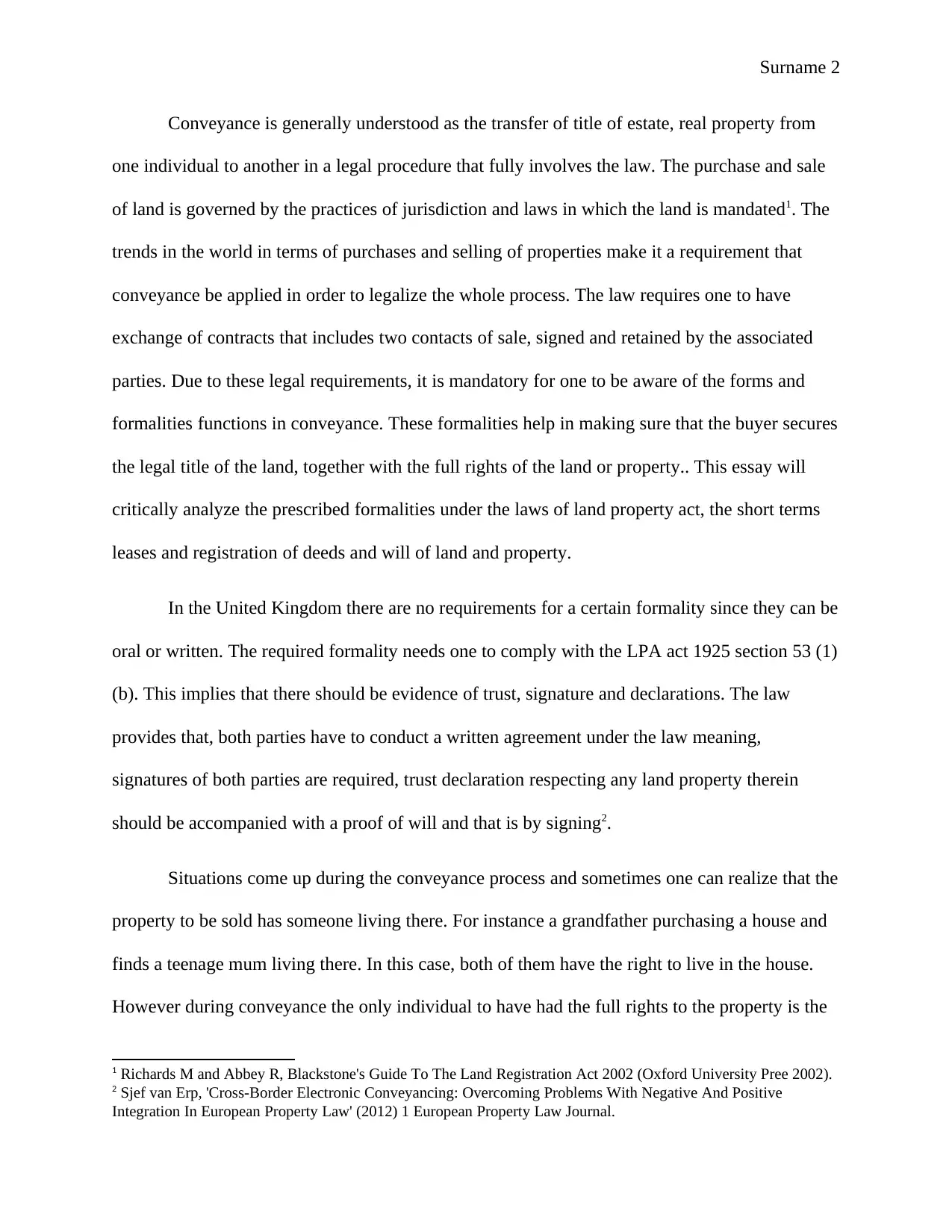
Surname 2
Conveyance is generally understood as the transfer of title of estate, real property from
one individual to another in a legal procedure that fully involves the law. The purchase and sale
of land is governed by the practices of jurisdiction and laws in which the land is mandated1. The
trends in the world in terms of purchases and selling of properties make it a requirement that
conveyance be applied in order to legalize the whole process. The law requires one to have
exchange of contracts that includes two contacts of sale, signed and retained by the associated
parties. Due to these legal requirements, it is mandatory for one to be aware of the forms and
formalities functions in conveyance. These formalities help in making sure that the buyer secures
the legal title of the land, together with the full rights of the land or property.. This essay will
critically analyze the prescribed formalities under the laws of land property act, the short terms
leases and registration of deeds and will of land and property.
In the United Kingdom there are no requirements for a certain formality since they can be
oral or written. The required formality needs one to comply with the LPA act 1925 section 53 (1)
(b). This implies that there should be evidence of trust, signature and declarations. The law
provides that, both parties have to conduct a written agreement under the law meaning,
signatures of both parties are required, trust declaration respecting any land property therein
should be accompanied with a proof of will and that is by signing2.
Situations come up during the conveyance process and sometimes one can realize that the
property to be sold has someone living there. For instance a grandfather purchasing a house and
finds a teenage mum living there. In this case, both of them have the right to live in the house.
However during conveyance the only individual to have had the full rights to the property is the
1 Richards M and Abbey R, Blackstone's Guide To The Land Registration Act 2002 (Oxford University Pree 2002).
2 Sjef van Erp, 'Cross-Border Electronic Conveyancing: Overcoming Problems With Negative And Positive
Integration In European Property Law' (2012) 1 European Property Law Journal.
Conveyance is generally understood as the transfer of title of estate, real property from
one individual to another in a legal procedure that fully involves the law. The purchase and sale
of land is governed by the practices of jurisdiction and laws in which the land is mandated1. The
trends in the world in terms of purchases and selling of properties make it a requirement that
conveyance be applied in order to legalize the whole process. The law requires one to have
exchange of contracts that includes two contacts of sale, signed and retained by the associated
parties. Due to these legal requirements, it is mandatory for one to be aware of the forms and
formalities functions in conveyance. These formalities help in making sure that the buyer secures
the legal title of the land, together with the full rights of the land or property.. This essay will
critically analyze the prescribed formalities under the laws of land property act, the short terms
leases and registration of deeds and will of land and property.
In the United Kingdom there are no requirements for a certain formality since they can be
oral or written. The required formality needs one to comply with the LPA act 1925 section 53 (1)
(b). This implies that there should be evidence of trust, signature and declarations. The law
provides that, both parties have to conduct a written agreement under the law meaning,
signatures of both parties are required, trust declaration respecting any land property therein
should be accompanied with a proof of will and that is by signing2.
Situations come up during the conveyance process and sometimes one can realize that the
property to be sold has someone living there. For instance a grandfather purchasing a house and
finds a teenage mum living there. In this case, both of them have the right to live in the house.
However during conveyance the only individual to have had the full rights to the property is the
1 Richards M and Abbey R, Blackstone's Guide To The Land Registration Act 2002 (Oxford University Pree 2002).
2 Sjef van Erp, 'Cross-Border Electronic Conveyancing: Overcoming Problems With Negative And Positive
Integration In European Property Law' (2012) 1 European Property Law Journal.
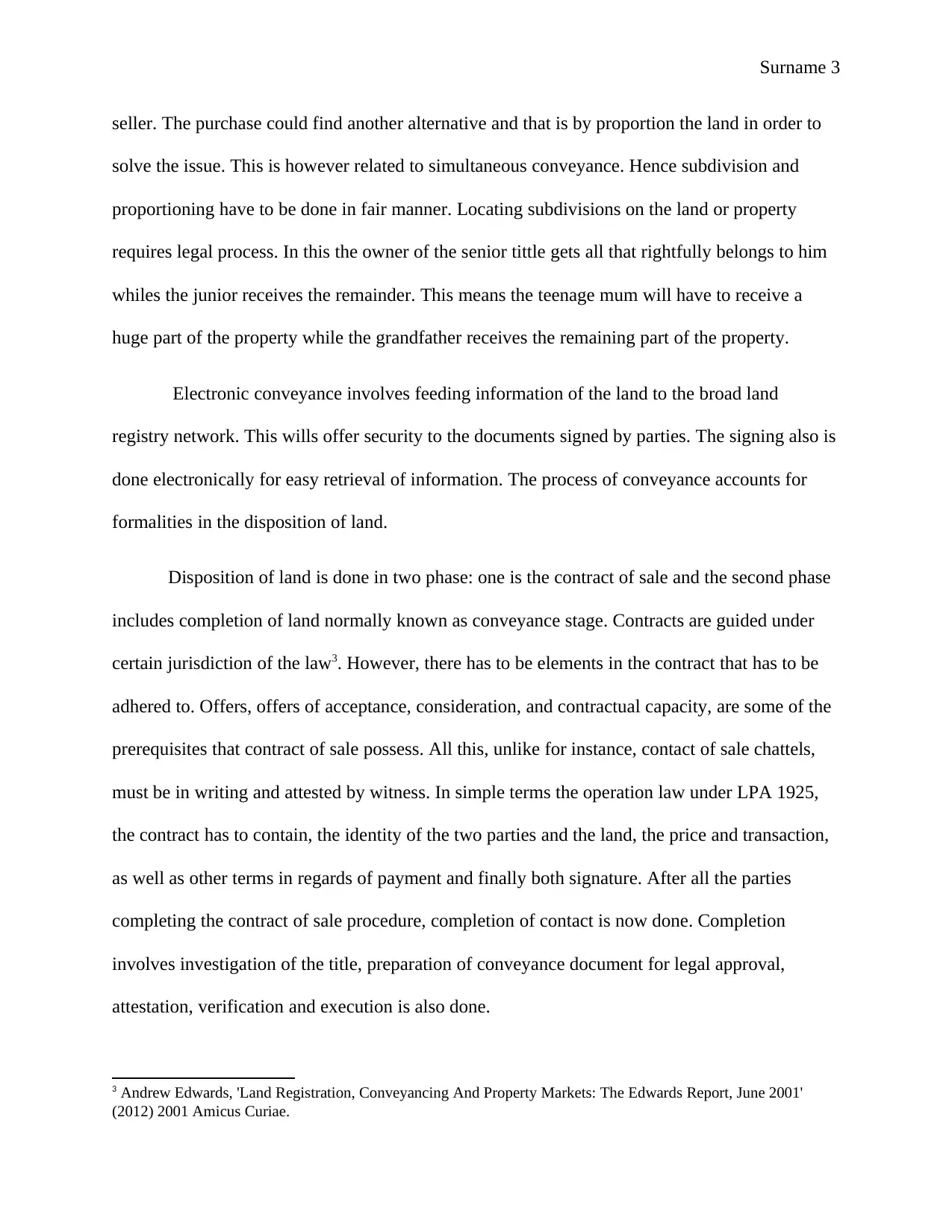
Surname 3
seller. The purchase could find another alternative and that is by proportion the land in order to
solve the issue. This is however related to simultaneous conveyance. Hence subdivision and
proportioning have to be done in fair manner. Locating subdivisions on the land or property
requires legal process. In this the owner of the senior tittle gets all that rightfully belongs to him
whiles the junior receives the remainder. This means the teenage mum will have to receive a
huge part of the property while the grandfather receives the remaining part of the property.
Electronic conveyance involves feeding information of the land to the broad land
registry network. This wills offer security to the documents signed by parties. The signing also is
done electronically for easy retrieval of information. The process of conveyance accounts for
formalities in the disposition of land.
Disposition of land is done in two phase: one is the contract of sale and the second phase
includes completion of land normally known as conveyance stage. Contracts are guided under
certain jurisdiction of the law3. However, there has to be elements in the contract that has to be
adhered to. Offers, offers of acceptance, consideration, and contractual capacity, are some of the
prerequisites that contract of sale possess. All this, unlike for instance, contact of sale chattels,
must be in writing and attested by witness. In simple terms the operation law under LPA 1925,
the contract has to contain, the identity of the two parties and the land, the price and transaction,
as well as other terms in regards of payment and finally both signature. After all the parties
completing the contract of sale procedure, completion of contact is now done. Completion
involves investigation of the title, preparation of conveyance document for legal approval,
attestation, verification and execution is also done.
3 Andrew Edwards, 'Land Registration, Conveyancing And Property Markets: The Edwards Report, June 2001'
(2012) 2001 Amicus Curiae.
seller. The purchase could find another alternative and that is by proportion the land in order to
solve the issue. This is however related to simultaneous conveyance. Hence subdivision and
proportioning have to be done in fair manner. Locating subdivisions on the land or property
requires legal process. In this the owner of the senior tittle gets all that rightfully belongs to him
whiles the junior receives the remainder. This means the teenage mum will have to receive a
huge part of the property while the grandfather receives the remaining part of the property.
Electronic conveyance involves feeding information of the land to the broad land
registry network. This wills offer security to the documents signed by parties. The signing also is
done electronically for easy retrieval of information. The process of conveyance accounts for
formalities in the disposition of land.
Disposition of land is done in two phase: one is the contract of sale and the second phase
includes completion of land normally known as conveyance stage. Contracts are guided under
certain jurisdiction of the law3. However, there has to be elements in the contract that has to be
adhered to. Offers, offers of acceptance, consideration, and contractual capacity, are some of the
prerequisites that contract of sale possess. All this, unlike for instance, contact of sale chattels,
must be in writing and attested by witness. In simple terms the operation law under LPA 1925,
the contract has to contain, the identity of the two parties and the land, the price and transaction,
as well as other terms in regards of payment and finally both signature. After all the parties
completing the contract of sale procedure, completion of contact is now done. Completion
involves investigation of the title, preparation of conveyance document for legal approval,
attestation, verification and execution is also done.
3 Andrew Edwards, 'Land Registration, Conveyancing And Property Markets: The Edwards Report, June 2001'
(2012) 2001 Amicus Curiae.
⊘ This is a preview!⊘
Do you want full access?
Subscribe today to unlock all pages.

Trusted by 1+ million students worldwide
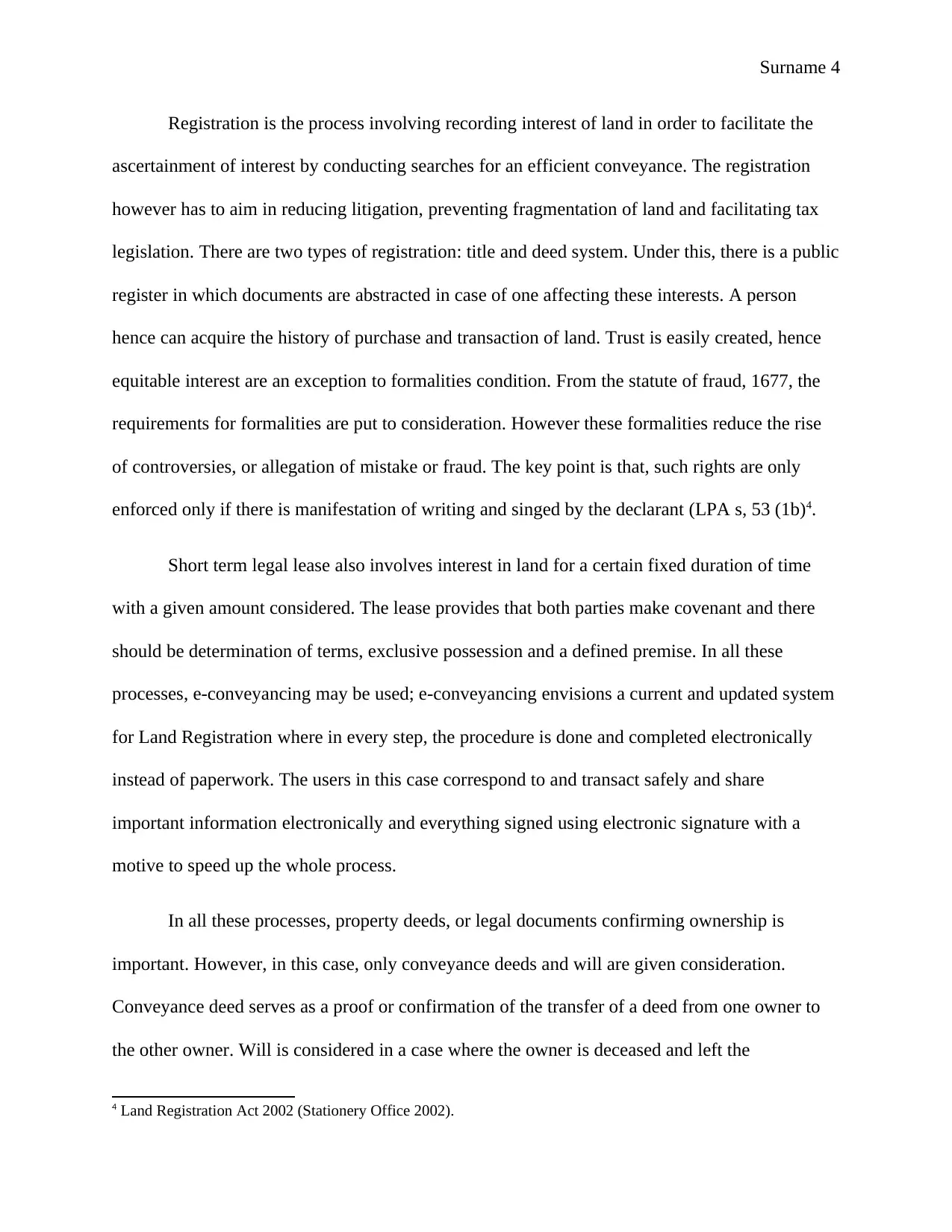
Surname 4
Registration is the process involving recording interest of land in order to facilitate the
ascertainment of interest by conducting searches for an efficient conveyance. The registration
however has to aim in reducing litigation, preventing fragmentation of land and facilitating tax
legislation. There are two types of registration: title and deed system. Under this, there is a public
register in which documents are abstracted in case of one affecting these interests. A person
hence can acquire the history of purchase and transaction of land. Trust is easily created, hence
equitable interest are an exception to formalities condition. From the statute of fraud, 1677, the
requirements for formalities are put to consideration. However these formalities reduce the rise
of controversies, or allegation of mistake or fraud. The key point is that, such rights are only
enforced only if there is manifestation of writing and singed by the declarant (LPA s, 53 (1b)4.
Short term legal lease also involves interest in land for a certain fixed duration of time
with a given amount considered. The lease provides that both parties make covenant and there
should be determination of terms, exclusive possession and a defined premise. In all these
processes, e-conveyancing may be used; e-conveyancing envisions a current and updated system
for Land Registration where in every step, the procedure is done and completed electronically
instead of paperwork. The users in this case correspond to and transact safely and share
important information electronically and everything signed using electronic signature with a
motive to speed up the whole process.
In all these processes, property deeds, or legal documents confirming ownership is
important. However, in this case, only conveyance deeds and will are given consideration.
Conveyance deed serves as a proof or confirmation of the transfer of a deed from one owner to
the other owner. Will is considered in a case where the owner is deceased and left the
4 Land Registration Act 2002 (Stationery Office 2002).
Registration is the process involving recording interest of land in order to facilitate the
ascertainment of interest by conducting searches for an efficient conveyance. The registration
however has to aim in reducing litigation, preventing fragmentation of land and facilitating tax
legislation. There are two types of registration: title and deed system. Under this, there is a public
register in which documents are abstracted in case of one affecting these interests. A person
hence can acquire the history of purchase and transaction of land. Trust is easily created, hence
equitable interest are an exception to formalities condition. From the statute of fraud, 1677, the
requirements for formalities are put to consideration. However these formalities reduce the rise
of controversies, or allegation of mistake or fraud. The key point is that, such rights are only
enforced only if there is manifestation of writing and singed by the declarant (LPA s, 53 (1b)4.
Short term legal lease also involves interest in land for a certain fixed duration of time
with a given amount considered. The lease provides that both parties make covenant and there
should be determination of terms, exclusive possession and a defined premise. In all these
processes, e-conveyancing may be used; e-conveyancing envisions a current and updated system
for Land Registration where in every step, the procedure is done and completed electronically
instead of paperwork. The users in this case correspond to and transact safely and share
important information electronically and everything signed using electronic signature with a
motive to speed up the whole process.
In all these processes, property deeds, or legal documents confirming ownership is
important. However, in this case, only conveyance deeds and will are given consideration.
Conveyance deed serves as a proof or confirmation of the transfer of a deed from one owner to
the other owner. Will is considered in a case where the owner is deceased and left the
4 Land Registration Act 2002 (Stationery Office 2002).
Paraphrase This Document
Need a fresh take? Get an instant paraphrase of this document with our AI Paraphraser
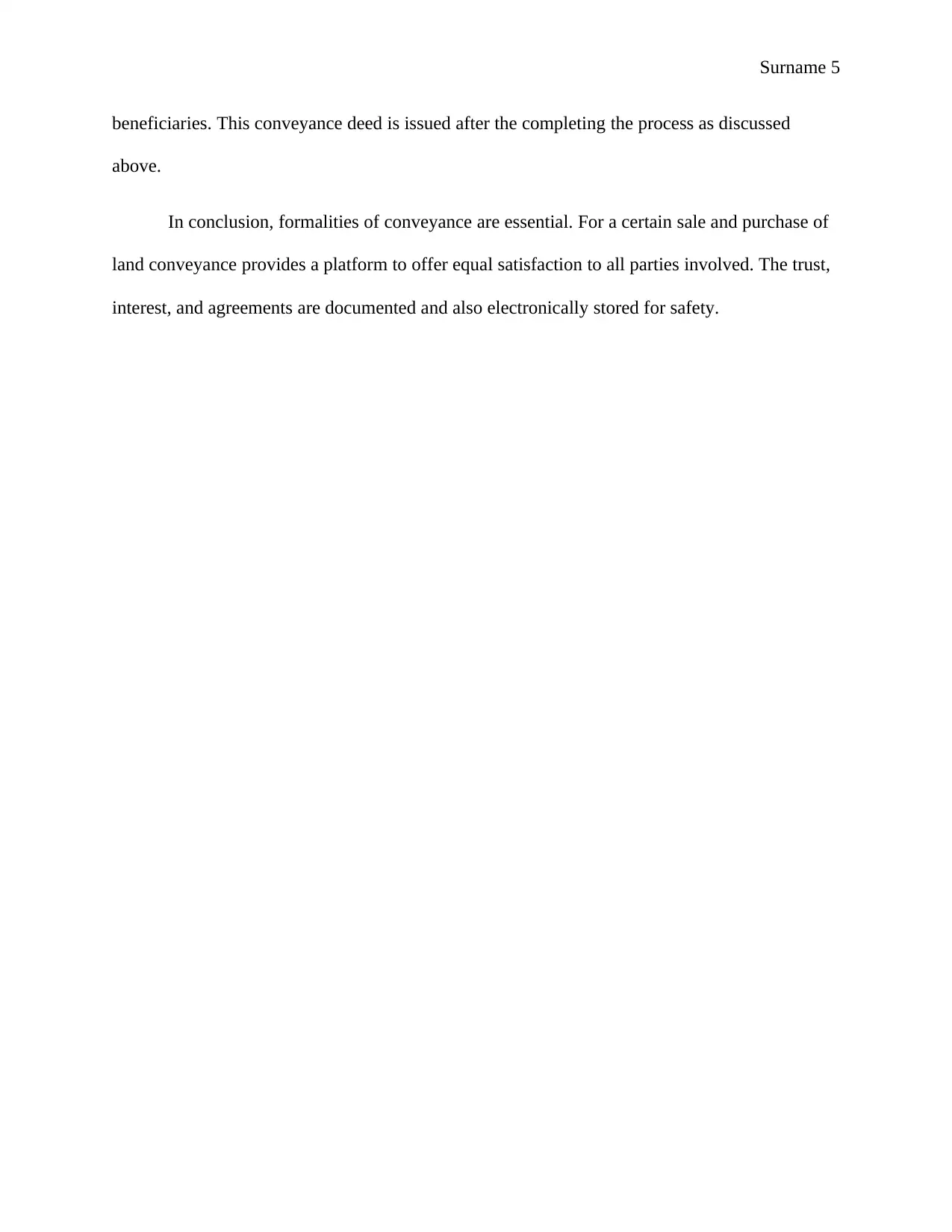
Surname 5
beneficiaries. This conveyance deed is issued after the completing the process as discussed
above.
In conclusion, formalities of conveyance are essential. For a certain sale and purchase of
land conveyance provides a platform to offer equal satisfaction to all parties involved. The trust,
interest, and agreements are documented and also electronically stored for safety.
beneficiaries. This conveyance deed is issued after the completing the process as discussed
above.
In conclusion, formalities of conveyance are essential. For a certain sale and purchase of
land conveyance provides a platform to offer equal satisfaction to all parties involved. The trust,
interest, and agreements are documented and also electronically stored for safety.
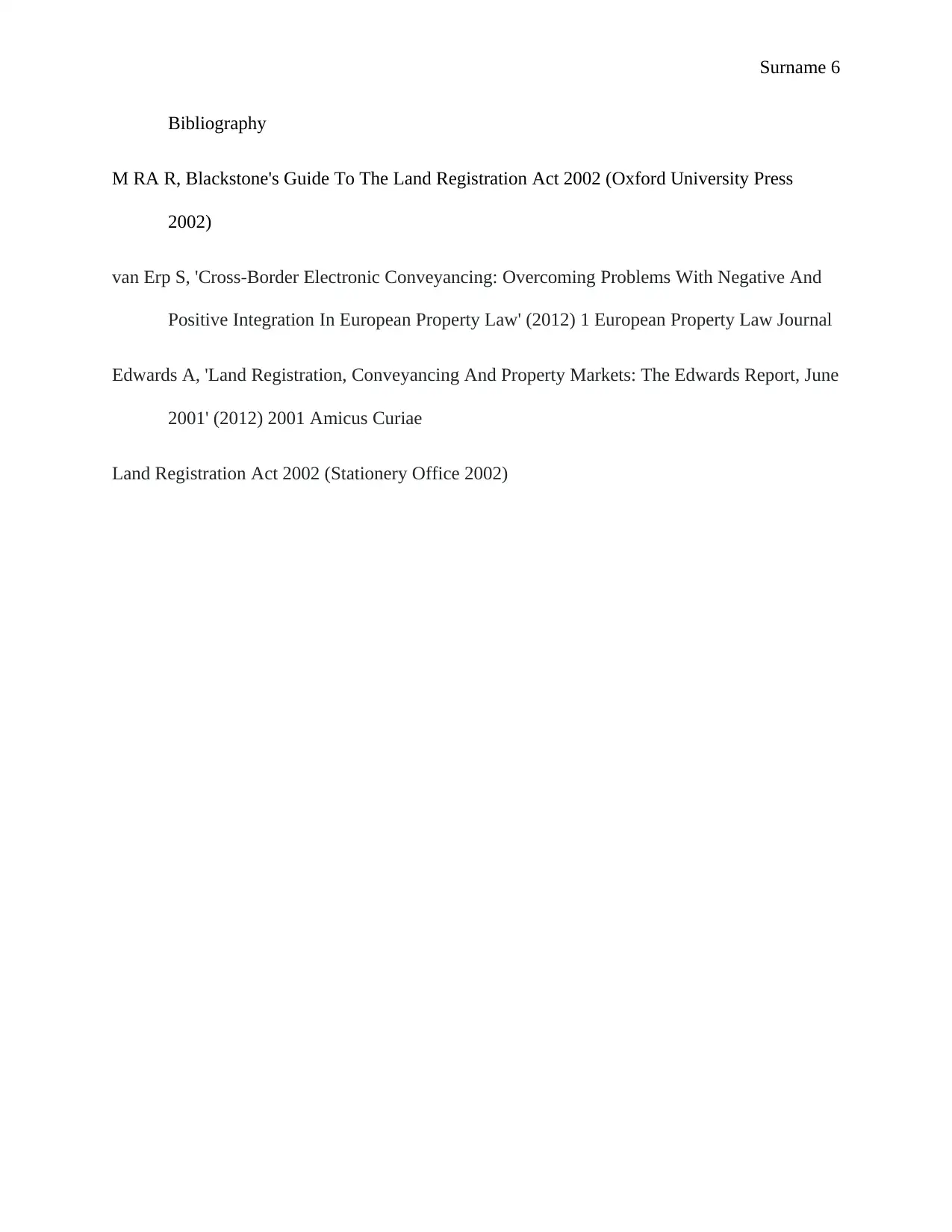
Surname 6
Bibliography
M RA R, Blackstone's Guide To The Land Registration Act 2002 (Oxford University Press
2002)
van Erp S, 'Cross-Border Electronic Conveyancing: Overcoming Problems With Negative And
Positive Integration In European Property Law' (2012) 1 European Property Law Journal
Edwards A, 'Land Registration, Conveyancing And Property Markets: The Edwards Report, June
2001' (2012) 2001 Amicus Curiae
Land Registration Act 2002 (Stationery Office 2002)
Bibliography
M RA R, Blackstone's Guide To The Land Registration Act 2002 (Oxford University Press
2002)
van Erp S, 'Cross-Border Electronic Conveyancing: Overcoming Problems With Negative And
Positive Integration In European Property Law' (2012) 1 European Property Law Journal
Edwards A, 'Land Registration, Conveyancing And Property Markets: The Edwards Report, June
2001' (2012) 2001 Amicus Curiae
Land Registration Act 2002 (Stationery Office 2002)
⊘ This is a preview!⊘
Do you want full access?
Subscribe today to unlock all pages.

Trusted by 1+ million students worldwide
1 out of 6
Related Documents
Your All-in-One AI-Powered Toolkit for Academic Success.
+13062052269
info@desklib.com
Available 24*7 on WhatsApp / Email
![[object Object]](/_next/static/media/star-bottom.7253800d.svg)
Unlock your academic potential
Copyright © 2020–2025 A2Z Services. All Rights Reserved. Developed and managed by ZUCOL.


